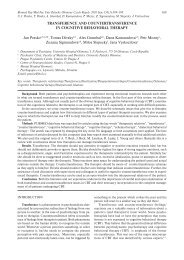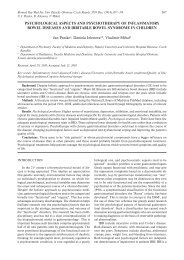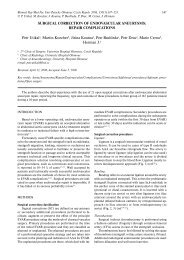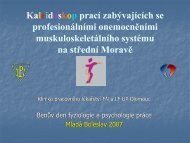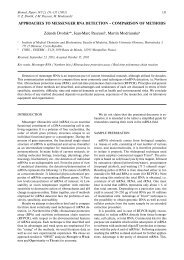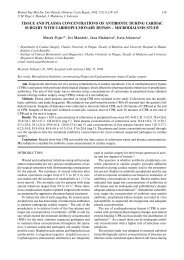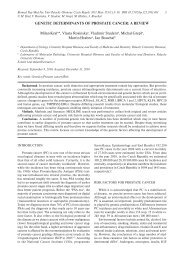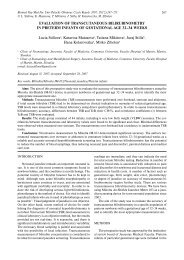Biomed Pap Med Fac Univ Palacky Olomouc Czech Repub. 2011 ...
Biomed Pap Med Fac Univ Palacky Olomouc Czech Repub. 2011 ...
Biomed Pap Med Fac Univ Palacky Olomouc Czech Repub. 2011 ...
You also want an ePaper? Increase the reach of your titles
YUMPU automatically turns print PDFs into web optimized ePapers that Google loves.
<strong>Biomed</strong> <strong>Pap</strong> <strong>Med</strong> <strong>Fac</strong> <strong>Univ</strong> <strong>Palacky</strong> <strong>Olomouc</strong> <strong>Czech</strong> <strong>Repub</strong>. <strong>2011</strong> Sep; 155(3):275–282. DOI 10.5507/bp.<strong>2011</strong>.041<br />
© M. Adamus, O, Jor, T. Vavreckova, L. Hrabalek, J. Zapletalova, T. Gabrhelik, H. Tomaskova, V. Janout<br />
275<br />
INTER-OBSERVER REPRODUCIBILITY OF 15 TESTS USED<br />
FOR PREDICTING DIFFICULT INTUBATION<br />
Milan Adamus a *, Ondrej Jor b , Tereza Vavreckova b , Lumir Hrabalek c , Jana Zapletalova d,e ,<br />
Tomas Gabrhelik a , Hana Tomaskova f , Vladimir Janout g<br />
a<br />
Department of Anesthesiology and Intensive Care <strong>Med</strong>icine, <strong>Univ</strong>ersity Hospital <strong>Olomouc</strong> and <strong>Fac</strong>ulty of <strong>Med</strong>icine and<br />
Dentistry, <strong>Palacky</strong> <strong>Univ</strong>ersity <strong>Olomouc</strong>, <strong>Czech</strong> <strong>Repub</strong>lic<br />
b<br />
<strong>Fac</strong>ulty of <strong>Med</strong>icine and Dentistry, <strong>Palacky</strong> <strong>Univ</strong>ersity <strong>Olomouc</strong><br />
c<br />
Department of Neurosurgery, <strong>Univ</strong>ersity Hospital <strong>Olomouc</strong> and <strong>Fac</strong>ulty of <strong>Med</strong>icine and Dentistry, <strong>Palacky</strong> <strong>Univ</strong>ersity<br />
<strong>Olomouc</strong><br />
d<br />
Department of <strong>Med</strong>ical Biophysics, <strong>Fac</strong>ulty of <strong>Med</strong>icine and Dentistry, <strong>Palacky</strong> <strong>Univ</strong>ersity <strong>Olomouc</strong><br />
e<br />
Institute of Molecular and Translational <strong>Med</strong>icine, <strong>Fac</strong>ulty of <strong>Med</strong>icine and Dentistry, <strong>Palacky</strong> <strong>Univ</strong>ersity <strong>Olomouc</strong><br />
f<br />
Department of Epidemiology and Public Health, <strong>Fac</strong>ulty of <strong>Med</strong>icine, Ostrava <strong>Univ</strong>ersity<br />
g<br />
Department of Preventive <strong>Med</strong>icine, <strong>Fac</strong>ulty of <strong>Med</strong>icine and Dentistry, <strong>Palacky</strong> <strong>Univ</strong>ersity <strong>Olomouc</strong><br />
E-mail: milan.adamus@seznam.cz<br />
Received: May 17, <strong>2011</strong>; Accepted: July 12, <strong>2011</strong><br />
Key words: Reproducibility/Prediction/Difficult intubation/Inter-Observer Variability<br />
Aim. To determine the inter-observer reproducibility of 15 tests used for predicting difficult tracheal intubation (DI).<br />
Material and methods. Following local ethics committee approval and informed consent, 101 volunteers were examined<br />
by two assessors using 15 tests for predicting DI. The two assessors who were blinded to the results of the other,<br />
examined each volunteer independently. Cohen’s kappa (κ) or first-order agreement coefficient (AC1) were used to<br />
measure agreement between assessor ratings on a qualitative scale. Agreement between two quantitative outcomes was<br />
described using the intraclass correlation coefficient (ICC) and Pearson’s (PCC) or Spearman’s (SCC) correlation<br />
coefficients. The following interpretation of the coefficients was used: poor (< 0.20), fair (0.21–0.40), satisfactory<br />
(0.41–0.60), good (0.61–0.80), and excellent (0.81–1.00).<br />
Results. Respective coefficients of inter-rater agreement and correlation coefficients were determined for the following<br />
parameters: pathologies associated with DI (κ=0.662, AC1=0.990), clinical impression (κ=-0.013, AC1=0.969),<br />
modified Mallampati test (κ=0.503, AC1=0.861), upper lip bite test (κ=0.370, AC1=0.897), temporo-mandibular<br />
joint movement (κ=0.088, AC1=0.797), max. anteroflexion of C-spine (ICC=0.136, SCC=0.391), max. retroflexion of<br />
C-spine (ICC=0.020, SCC=0.284), mandibular length (ICC=0.301, SCC=0.553), neck circumference (ICC=0.832,<br />
SCC=0.928), hyo-mental distance (ICC=0.378, SCC=0.472), thyro-mental distance (ICC=–0.002, PCC=0.265), sternomental<br />
distance (ICC=0.674, PCC=0.815), and finally, inter-incisor gap (ICC=0.695, PCC=0.785). Two tests (positive<br />
history of DI and retrogenia), were excluded from calculation because no positive cases were found.<br />
Conclusion. Best inter-rater agreement was found for the assessment of neck circumference while the highest discrepancies<br />
between raters were in goniometrically-measured mobility of the C-spine.<br />
Many of the pre-operative airway tests had only fair inter-observer reproducibility. This may be one reason why<br />
models for predicting difficult intubation are not universally reliable.<br />
INTRODUCTION<br />
Tracheal intubation is a mainstay of airway management<br />
during general anesthesia and usually performed<br />
uneventfully. However, if the intubation appears to be difficult<br />
or impossible after induction of anesthesia, critical<br />
oxygen desaturation may occur. Unanticipated difficult<br />
intubation can be more dangerous than a predicted one<br />
when a potential airway problem is detected before anesthesia.<br />
There are many clinical tests for predicting difficult<br />
intubation (DI). Unfortunately, single tests, such<br />
as Mallampati classification, are not reliable enough to<br />
prospectively detect all cases of DI (ref. 1-4 ). Combining<br />
several tests may be more effective and may improve the<br />
accuracy of the assessment. However, studies have demonstrated<br />
conflicting results in the predictive value of models<br />
consisting of different test combinations 5-7 . A correct<br />
model must be both reliable in classifying patients’ airway<br />
and give the same results when performed by different<br />
assessors (reproducibility).<br />
The aim of this study was to determine the inter-rater<br />
agreement between two assessors (medical students) using<br />
fifteen parameters for predicting difficult intubation.<br />
MATERIALS AND METHODS<br />
Following local ethics committee approval and informed<br />
consent, 101 volunteers (medical students) were
276 M. Adamus, O, Jor, T. Vavreckova, L. Hrabalek, J. Zapletalova, T. Gabrhelik, H. Tomaskova, V. Janout<br />
Table 1. Parameters for predicting difficult intubation used in the study.<br />
Parameter Methods Ranges and Units<br />
Positive history of DI<br />
Pathologies associated<br />
with DI<br />
Clinical impression<br />
Mallampati classification as<br />
modified by Samsoon and<br />
Young (MMT, Modified<br />
Mallampati test) (ref. 16 )<br />
Upper lip bite test (ULBT)<br />
(ref. 17–19 )<br />
Retrogenia<br />
(receding mandible)<br />
Hyo-mental distance (HMD)<br />
TM joint movement<br />
Maximal anteroflexion of the<br />
C-spine<br />
Maximal retroflexion of the<br />
C-spine<br />
Mandibular length<br />
Neck circumference<br />
Thyro-mental distance (TMD)<br />
Sterno-mental distance<br />
(SMD)<br />
Inter-incisor gap (IIG)<br />
Does the patient have a history of difficult<br />
intubation<br />
Does the patient have a condition commonly<br />
associated with difficult intubation<br />
Hard to define – a feeling of a potential<br />
airways problem<br />
Head in neutral position, full mouth<br />
opening, protrusion of the tongue:<br />
pharyngeal view<br />
Biting the upper lip with the lower incisors<br />
A line drawn from the upper eye lid to<br />
the maxilla<br />
Distance: the body of the hyoid bone<br />
– the mentum<br />
Full mouth opening (IIG) + slux<br />
• The goniometer head to the ear canal<br />
• First arm in the long axis of the neck<br />
above the ear<br />
• Second arm to the nasal wing<br />
Distance: outer angle – the middle<br />
of the chin (follow the shape of the<br />
mandible)<br />
Measured at the level of the cricoid,<br />
perpendicular to the long axis of the<br />
neck<br />
Distance: superior thyroid notch – the<br />
lower edge of the middle of the chin<br />
Distance: jugulum – the lower edge of<br />
the middle of the chin<br />
Full mouth opening, distance between<br />
the incisors (gums)<br />
yes – no<br />
specify (ankylosing spondylitis,<br />
acromegaly, etc.)<br />
yes – no<br />
1 = the soft palate, fauces, uvula<br />
and pillars visible<br />
2 = the soft palate, fauces and base<br />
of uvula visible<br />
3 = the soft palate visible<br />
4 = the hard palate only visible<br />
1 = the incisors in front of the lip<br />
2 = the lip partly visible<br />
3 = the lip visible<br />
yes – the chin behind the line<br />
no – the chin in front of the line<br />
mm<br />
1 = IIG > 50 mm + slux > 0<br />
2 = IIG < 50 mm + slux > 0<br />
3 = IIG < 50 mm + slux < 0<br />
degrees<br />
degrees<br />
cm<br />
cm<br />
mm<br />
mm<br />
mm<br />
DI = difficult intubation, TM = temporo-mandibular, slux = subluxation (maximal forward protrusion of the lower incisors beyond the upper<br />
incisors)<br />
examined (2–5/day) with 15 tests for predicting difficult<br />
intubation. In random order, each volunteer was examined<br />
in one session independently by two co-authors (O. J.,<br />
T. V.) who were thoroughly instructed in carrying out the<br />
tests. Examinations performed by assessor O. J. created<br />
the O group while the group T included the corresponding<br />
examinations done by T. V. The measurements were<br />
done under standardized conditions and each assessor<br />
was blinded to the results of the other. The airway assessment<br />
consisted of fifteen parameters and measurements<br />
(see Table 1).<br />
The data were recorded into an Excel spreadsheet<br />
application (Microsoft Office 2007 SP2, Microsoft<br />
Corporation), and statistically analyzed (SPSS v. 15.0<br />
statistical software, SPSS Inc., Chicago, USA).
Inter-observer reproducibility of 15 tests used for predicting difficult intubation<br />
277<br />
Descriptive statistics was used to summarize the demographic<br />
data of the volunteers and comparison of genders<br />
was done with a Mann-Whitney U test. A p-value less<br />
than 0.05 was considered significant. Agreement between<br />
assessors (percentage), Cohen’s kappa (κ), or first-order<br />
agreement coefficient (AC1) were used for comparison<br />
of qualitative parameters. The inter-rater agreement in<br />
measurement of quantitative parameters was analyzed<br />
with the intraclass correlation coefficient (ICC) with<br />
95% confidence intervals and Pearson’s or Spearman’s<br />
correlation coefficients. We used the following interpretation<br />
8 of the inter-rater agreement in the kappa values and<br />
correlation coefficients: poor (< 0.20), fair (0.21–0.40),<br />
satisfactory (0.41–0.60), good (0.61–0.80), and finally<br />
excellent (0.81–1.00). The distribution of inter-observer<br />
differences was tested with the Kolmogorov-Smirnov test.<br />
Data with normal distributions were compared using the<br />
paired Student’s t-test; the Wilcoxon signed-rank test was<br />
used for data that did not pass the normality test. Scatter<br />
plot and Bland-Altman plot 9 were used to demonstrate<br />
the systematic bias for measurements between assessors.<br />
RESULTS<br />
A total of 101 volunteers were enrolled and they<br />
all successfully finished the study with no drop-outs.<br />
Thirty (29.7%) were males (median age 23 years, range<br />
20–26 years; median height 184 cm, range 173–190 cm;<br />
median weight 82 kg, range 66–100 kg; median BMI<br />
24.0 kg m -2 , range 21.1–31.7 kg m -2 ) and 71 (70.3%) were<br />
females (median age 23 years, range 20–25 years; median<br />
height 168 cm, range 153–182 cm; median weight 61 kg,<br />
range 45–83 kg; median BMI 21.5 kg m -2 , range 16.2–<br />
30.5 kg m -2 ). There was no significant difference in age for<br />
the two genders (p=0.847). Compared to females, males<br />
were significantly taller (p
278 M. Adamus, O, Jor, T. Vavreckova, L. Hrabalek, J. Zapletalova, T. Gabrhelik, H. Tomaskova, V. Janout<br />
Table 2. Inter-observer agreement – qualitative parameters.<br />
Parameter<br />
Pathologies associated<br />
with DI<br />
Inter-observer<br />
agreement (%)<br />
Cohen’s kappa ± SE<br />
Strength of<br />
agreement<br />
(based on kappa)<br />
AC1<br />
Strength of<br />
agreement<br />
(based on<br />
AC1)<br />
99 0.662 ± 0.316 good 0.990 excellent<br />
Clinical impression 97 -0.013 ± 0.009 poor 0.969 excellent<br />
MMT (I, II, III, IV) 68 0.452 ± 0.073 satisfactory n/A n/A<br />
MMT (I+II, III+IV) 89 0.503 ± 0.127 satisfactory 0.861 excellent<br />
ULBT (I, II, III) 68 0.443 ± 0.079 satisfactory n/A n/A<br />
ULBT (I+II, III) 91 0.370 ± 0.156 fair 0.897 excellent<br />
TM joint movement<br />
(I, II, III)<br />
TM joint movement<br />
(I+II, III)<br />
64 0.390 ± 0.067 fair n/A n/A<br />
83 0.088 ± 0.083 poor 0.797 good<br />
SE = standard error, AC1 = first-order agreement coefficient 14,15 , n/A = not applicable<br />
DI = difficult intubation, MMT = Modified Mallampati test 16 , ULBT = Upper lip bite test 17–19 , TM = temporo-mandibular<br />
Inter-observer agreement 8 : poor (< 0.20), fair (0.21–0.40), satisfactory (0.41–0.60), good (0.61–0.80), excellent (0.81–1.00)<br />
Table 3. Inter-observer agreement – quantitative parameters.<br />
Parameter ICC 95%CI<br />
Maximal anteroflexion<br />
of the C-spine<br />
Maximal retroflexion<br />
of the C-spine<br />
Max. anteroflexion<br />
+ retroflexion of the<br />
C-spine<br />
Strength<br />
of agreement<br />
(based on ICC)<br />
Correl.<br />
coef.<br />
Strength of agreement<br />
(based on correl. coef.)<br />
0.136 -0.060–0.322 poor 0.391 a fair<br />
0.020 -0.175–0.213 poor 0.284 a fair<br />
-0.109 -0.297–0.087 poor 0.313 a fair<br />
Mandibular length 0.301 0.113–0.468 fair 0.553 a satisfactory<br />
Neck circumference 0.832 0.761–0.884 excellent 0.928 a excellent<br />
HMD 0.378 0.198–0.533 fair 0.472 a satisfactory<br />
TMD -0.002 -0.196–0.192 poor 0.265 b fair<br />
SMD 0.674 0.553–0.768 good 0.815 b excellent<br />
IIG 0.695 0.579–0.784 good 0.785 b good<br />
ICC = Intraclass correlation coefficient, 95%CI = Confidence interval 95%, a Spearman’s correlation coefficient, b Pearson’s correlation coefficient<br />
HMD = Hyo-mental distance, TMD = Thyro-mental distance, SMD = Sterno-mental distance, IIG = Inter-incisor gap<br />
Inter-observer agreement 8 : poor (< 0.20), fair (0.21–0.40), satisfactory (0.41–0.60), good (0.61–0.80), excellent (0.81–1.00).
Inter-observer reproducibility of 15 tests used for predicting difficult intubation<br />
279<br />
Table 4. Systematic deviation (bias) in the measurements of quantitative parameters. Minimum, maximum, mean,<br />
and percentiles of differences between assessors.<br />
Parameter [difference between<br />
assessors O and T]<br />
dif Max. anteroflexion of the<br />
C-spine (degrees) [O-T]<br />
dif Max. retroflexion of the<br />
C-spine (degrees) [O-T]<br />
dif Max. anteroflexion+Max.<br />
retroflexion (degrees) [O-T]<br />
mean<br />
range<br />
25<br />
(lower quartile)<br />
percentiles<br />
50<br />
(median)<br />
75<br />
(upper quartile)<br />
-8.2 -34.0–35.0 -15.0 -8.0 -1.0<br />
-10.1 -35.0–14.0 -17.0 -9.0 -2.5<br />
-18.2 -51.0–35.0 -27.5 -19.0 -7.5<br />
dif Mandibular length (cm) [O-T] 0.7 -1.3–2.5 0.1 0.5 1.1<br />
dif Neck circumference (cm)<br />
[O-T]<br />
1.8 -1.5–7.5 1.3 2.0 2.3<br />
dif HMD (mm) [O-T] -4.3 -25.0–21.0 -10.0 -3.0 0<br />
dif TMD (mm) [O-T] -13.6 -55.0–38.0 -22.0 -13.0 -7.0<br />
dif SMD (mm) [O-T] -10.6 -77.0–30.0 -15.0 -10.0 -5.0<br />
dif IIG (mm) [O-T] -3.5 -19.0–7.0 -5.0 -3.0 -0.5<br />
O = assessor O, T = assessor T<br />
HMD = Hyo-mental distance, TMD = Thyro-mental distance, SMD = Sterno-mental distance, IIG = Inter-incisor gap<br />
sufficient because the inter-rater bias in the measurements<br />
of quantitative parameters was substantial. <strong>Fac</strong>tors related<br />
to the examined volunteer may be based on misunderstanding<br />
or not following the instructions appropriately.<br />
When necessary, the required maneuvers were clearly<br />
described several times and demonstrated repeatedly 11 .<br />
This study is relevant not only to pre-anesthetic airway<br />
assessment and predicting DI. The results present a statistical<br />
challenge, too.<br />
The Cohen’s kappa coefficient (κ) is a statistical measure<br />
of inter-rater agreement for qualitative (categorical)<br />
items 12,13 . Kappa-values range from -1.0 to 1.0. Negative<br />
values occur when agreement is weaker than expected<br />
by chance. When we get κ=0, the agreement is the same<br />
as would be expected by chance, κ=1.0 indicates perfect<br />
agreement above chance. However, in our study, the high<br />
percentage agreement between assessors for some parameters<br />
did not correspond to low κ-values (see Table 2). For<br />
these parameters, first-order agreement coefficient (AC1)<br />
was calculated as an alternative to the κ coefficient. Some<br />
authors believe that the AC1 value reflects the inter-rater<br />
agreement more realistically than the Cohen’s kappa coefficient<br />
14,15 . The limitation of the AC1 is that it can be<br />
used for contingency tables 2 × 2 only. When a qualitative<br />
parameter has more than two values, either another<br />
agreement coefficient (AC2) has to be used or some<br />
groups have to be merged for AC1 calculations. In our<br />
study, MMT (Modified Mallampati test) (ref. 16 ), ULBT<br />
(Upper lip bite test) 17-19 and Temporo-mandibular (TM)<br />
joint movement were the relevant parameters suitable for<br />
merging groups.<br />
In three volunteers, clinical impression of potential<br />
DI was positive (one in the O group, two in the T group).<br />
This parameter had poor inter-observer correlation when<br />
measured with Cohen’s kappa coefficient (-0.013), but<br />
excellent if AC1 was used (0.969). Very low incidence of<br />
positive cases is a limitation of these results.<br />
No volunteer declared a positive history of DI. This<br />
could be for two reasons. Either the volunteer had had no<br />
anesthesia or the intubation for his/her previous anesthesia<br />
was not difficult. As we were unable to distinguish<br />
between these two groups and the incidence of positive<br />
anamnesis of DI was zero, this parameter was excluded<br />
from statistical analysis. The same applied to retrogenia:<br />
there was no positive case in the groups.<br />
Pathologies associated with DI were detected only in<br />
two volunteers. The agreement between the assessors was<br />
as high as 99%. Based on the Cohen’s kappa coefficient,<br />
good agreement was detected (κ=0.662). When AC1 was<br />
used, the strength agreement was graded as excellent<br />
(AC1=0.99). These results show the advantage of AC1<br />
over Cohen’s kappa coefficient. As we intuitively feel,<br />
when the examinations of the assessors were identical in<br />
99% cases, the degree of agreement should be described<br />
as excellent. On the other hand, one must take into consideration<br />
the low incidence of pathologies determined<br />
and probably not present in the study group.
280 M. Adamus, O, Jor, T. Vavreckova, L. Hrabalek, J. Zapletalova, T. Gabrhelik, H. Tomaskova, V. Janout<br />
Four Grades (I, II, III, IV) in the MMT (Modified<br />
Mallampati test) (ref. 1-4,16 ) were merged into two – (I + II)<br />
and (III + IV). This is reasonable because Grades I and<br />
II are considered an unrestricted pharyngeal view while<br />
Grades III and IV indicate a limited view 3,16 . 89% volunteers<br />
were assigned the same MMT Grade by both<br />
assessors, the Cohen’s kappa coefficient was 0.503 (satisfactory),<br />
and AC1 was 0.861 (excellent). In a previous<br />
study, we demonstrated that the MMT, when performed<br />
alone, was not a reliable predictor of DI. This limitation<br />
of MMT may partially be due to inconsistent assessments<br />
by the observers.<br />
For the ULBT (ref. 17-19 ), there was agreement between<br />
the assessors in 91% cases (κ=0.370, AC1=0.897).<br />
Similarly, in the parameter TM joint movement, the<br />
inter-observer agreement was in 83% cases (κ=0.088,<br />
AC1=0.797).<br />
The inter-rater agreement for quantitative measurements<br />
was assessed with ICC and correlation coefficients<br />
(based on data distribution, Pearson’s or Spearman’s coefficient<br />
were used). Generally, strength of agreement based<br />
on ICC was more conservative (giving “worse” results)<br />
than the strength judged by Pearson’s or Spearman’s correlation<br />
coefficients. Best agreement between the assessors<br />
was in the measurement of neck circumference (both<br />
ICC and Spearman’s correlation coefficient described<br />
it as excellent). One can only speculate that the best degree<br />
of agreement was due to a relative simplicity and<br />
well-defined and unambiguous measurement method for<br />
the neck circumference. In contrast, the lowest level of<br />
agreement was in the measurement of neck movements.<br />
Maximal anteroflexion and retroflexion were examined<br />
with a goniometer. Despite thorough pre-study instructions,<br />
at the end of the study, both assessors felt and expressed<br />
uncertainty about the accuracy of the method.<br />
The assessment of neck mobility is more complex and<br />
relies on correct identification of anatomical landmarks<br />
and patient co-operation 8 . The most important difficulty<br />
was in determination of neutral head position from<br />
which both maximal anteroflexion and retroflexion were<br />
measured. This is a serious limitation of the goniometric<br />
measurements used.<br />
The range of the ICC coefficient and Pearson’s or<br />
Spearman’s correlation coefficients lies between -1 and<br />
+1. All coefficients describe the relationship between the<br />
paired measurements made by two assessors; the correlation<br />
coefficients provide no information about systematic<br />
deviation (bias). Bias means that one assessor consistently<br />
measures or classifies the given parameter differently from<br />
the second one. The Pearson’s or Spearman’s correlation<br />
coefficients can be very high even in the presence of a<br />
high inter-observer bias.<br />
Wilcoxon signed-rank test and paired Student’s t-test,<br />
respectively, showed a significant bias in the measurements<br />
of all quantitative parameters between the assessors<br />
(p
Inter-observer reproducibility of 15 tests used for predicting difficult intubation<br />
281<br />
ease of tracheal intubation could not be determined. For<br />
this reason, in spite of inter-observer bias in most parameters,<br />
we were not able to distinguish which measurement,<br />
if any, reflected the reality.<br />
To be useful in clinical settings, a model for predicting<br />
DI should be simple and feasible, with high accuracy, sensitivity<br />
and positive predictive value to identify all patients<br />
in whom intubation will be difficult 5 . These criteria can<br />
only be met when the input data are correct and consistent.<br />
If not, the construction of a model predicting DI<br />
may become rather a mathematic entertainment for the<br />
particular rater than a valuable clinical tool.<br />
CONCLUSION<br />
Although performed under standardized conditions,<br />
not all tests for predicting DI achieved acceptable interobserver<br />
reproducibility in our study. Best agreement was<br />
demonstrated for the assessment of neck circumference<br />
while the highest discrepancies between raters were in<br />
goniometrically-measured mobility of the C-spine (max.<br />
anteroflexion and retroflexion). The high inter-observer<br />
variability of examinations may be one reason why the<br />
models for predicting DI are not reliable in all cases.<br />
ACKNOWLEDGEMENTS<br />
The authors gratefully acknowledge financial support<br />
from the <strong>Czech</strong> Ministry of Health Internal Grant Agency –<br />
project No. NS 9618–4/2008.<br />
The authors express their sincere thanks to Prof. Jaroslav<br />
Vesely and Ms. Vera Langerova (Department of Pathological<br />
Physiology, <strong>Fac</strong>ulty of <strong>Med</strong>icine and Dentistry, <strong>Palacky</strong><br />
<strong>Univ</strong>ersity <strong>Olomouc</strong>, <strong>Czech</strong> <strong>Repub</strong>lic) for valuable advice<br />
and critical reviewing the manuscript.<br />
REFERENCES<br />
1. Lee A, Fan LT, Gin T, Karmakar MK, Ngan Kee WD. A systematic<br />
review (meta-analysis) of the accuracy of the Mallampati tests to<br />
predict the difficult airway. Anesth Analg 2006;102:1867-78.<br />
2. Bindra A, Prabhakar H, Singh GP, Ali Z, Singhal V. Is the modified<br />
Mallampati test performed in supine position a reliable predictor<br />
of difficult tracheal intubation J Anesth 2010;24:482-5.<br />
3. Adamus M. Comment on the article by Bindra A et al. Is the<br />
modified Mallampati test performed in supine position a reliable<br />
predictor of difficult tracheal intubation J Anesth <strong>2011</strong>;25:135.<br />
4. Law JA. Relying on just a few predictors of easy airway management<br />
may bite back! Anesth Analg 2008;106:668.<br />
5. Naguib M, Scamman FL, O'Sullivan C, Aker J, Ross AF, Kosmach<br />
S, Ensor JE. Predictive performance of three multivariate difficult<br />
tracheal intubation models: a double-blind, case-controlled study.<br />
Anesth Analg 2006;102:818-24.<br />
6. Wilson ME, Spiegelhalter D, Robertson JA, Lesser P. Predicting<br />
difficult intubation. Br J Anaesth 1988;61:211-6.<br />
7. Arné J, Descoins P, Fusciardi J, Ingrand P, Ferrier B, Boudigues D,<br />
Ariès J. Preoperative assessment for difficult intubation in general<br />
and ENT surgery: predictive value of a clinical multivariate risk<br />
index. Br J Anaesth 1998;80:140-6.<br />
8. Rosenstock C, Gillesberg I, Gätke MR, Levin D, Kristensen<br />
MS, Rasmussen LS. Inter-observer agreement of tests used for<br />
prediction of difficult laryngoscopy/tracheal intubation. Acta<br />
Anaesthesiol Scand 2005;49:1057-62.<br />
9. Bland JM, Altman DG. Statistical methods for assessing agreement<br />
between two methods of clinical measurement. Lancet 1986;Feb<br />
8;1(8476):307-10.<br />
10. Hilditch WG, Kopka A, Crawford JM, Asbury AJ. Interobserver<br />
reliability between a nurse and anaesthetist of tests used for predicting<br />
difficult tracheal intubation. Anaesthesia 2004;59:881-4.<br />
11. Karkouti K, Rose DK, Ferris LE, Wigglesworth DF, Meisami-Fard<br />
T, Lee H. Inter-observer reliability of ten tests used for predicting<br />
difficult tracheal intubation. Can J Anaesth 1996;43:554-9.<br />
12. Uebersax JS. Kappa Coefficients. Cited [<strong>2011</strong>, April 11]. Available<br />
from: http://www.john-uebersax.com/stat/kappa.htm<br />
13. Ben-David A. Comparison of classification accuracy using Cohen’s<br />
Weighted Kappa. Expert Systems with Applications 2008;34:825-<br />
32.<br />
14. Gwet KL. Computing inter-rater reliability and its variance in the<br />
presence of high agreement. Br J Math Stat Psychol 2008;61:29-48.<br />
15. Blood E, Spratt KF. Disagreement on Agreement: Two Alternative<br />
Agreement Coefficients. Statistics and Data Analysis. SAS<br />
Global Forum 2007. <strong>Pap</strong>er 186–2007. Cited [<strong>2011</strong>, April 11,<br />
<strong>2011</strong>]. Available from: http://www2.sas.com/proceedings/forum2007/186-2007.pdf<br />
16. Samsoon GL, Young JR. Difficult tracheal intubation: a retrospective<br />
study. Anaesthesia 1987;42:487-90.<br />
17. Khan ZH, Kashfi A, Ebrahimkhani E. A comparison of the upper<br />
lip bite test (a simple new technique) with modified Mallampati<br />
classification in predicting difficulty in endotracheal intubation: a<br />
prospective blinded study. Anesth Analg 2003;96:595-9.<br />
18. Hester CE, Dietrich SA, White SW. A comparison of preoperative<br />
airway assessment techniques: the modified Mallampati and the<br />
upper lip bite test. AANA J 2007;75:177-82.<br />
19. Myneni N, O'Leary AM, Sandison M, Roberts K. Evaluation of<br />
the upper lip bite test in predicting difficult laryngoscopy. J Clin<br />
Anesth 2010;22:174-8.<br />
20. Orozco-Díaz E, Alvarez-Ríos JJ, Arceo-Díaz JL, Ornelas-Aguirre<br />
JM. Predictive factors of difficult airway with known assessment<br />
scales. Cir Cir 2010;78:393-9.<br />
21. Torres K, Patel AA, Styliński K, Błoński M, Torres A, Staśkiewicz<br />
G, Maciejewski R, Wojtaszek M. The body constitution of patients<br />
and intubation scales as predictors of difficult intubation considered<br />
in relation to the experience of the intubator. Folia Morphol<br />
(Warsz). 2008;67:171-4.<br />
22. Merino García M, Marcos Vidal JM, García Pelaz R, Díez Burón F,<br />
España Fuente L, Bermejo González JC. Evaluation of a protocol<br />
for predicting difficult airway in routine practice: interobserver<br />
agreement. Rev Esp Anestesiol Reanim 2010;57:473-8.




